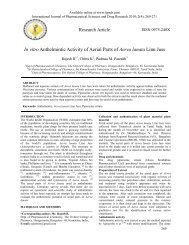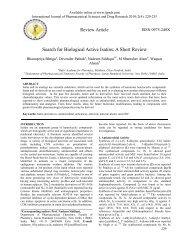Lawsonia inermis Linnaeus - International Journal of ...
Lawsonia inermis Linnaeus - International Journal of ...
Lawsonia inermis Linnaeus - International Journal of ...
Create successful ePaper yourself
Turn your PDF publications into a flip-book with our unique Google optimized e-Paper software.
Chaudhary et al. / <strong>Lawsonia</strong> <strong>inermis</strong> <strong>Linnaeus</strong>: A Phytopharmacological ……………….<br />
fever, leucorrhoea, diabetes, cardiac disease,<br />
hepatoprotective and colouring agent. [10-12]<br />
Henna leaf has an orange-red dye and leaf paste or powder is<br />
widely used for decorating hands, nails and feet with<br />
patterns. It is also used as a hair dye. It is used for alleviating<br />
jaundice, skin diseases, venereal diseases, smallpox and<br />
spermatorrhoea. Flowers are very fragrant and used to<br />
extract a perfume, which is used as base for local scents. An<br />
infusion <strong>of</strong> the flowers is a valuable application to bruises.<br />
Decoction <strong>of</strong> the flowers is describes as an emmenagogue.<br />
Seeds are deodorant. Powered seeds with real ghee (clarified<br />
butter) are effective against dysentery. Seeds in powered<br />
form are good medicine for liver disorders and associated<br />
problems. The bark is applied in the form <strong>of</strong> a decoction to<br />
burns and scalds. It is given internally in a variety <strong>of</strong><br />
affections, such as jaundice, enlargement <strong>of</strong> the spleen,<br />
calculus, as an alternative in leprosy and obstinate skin<br />
affections. Root is considered as a potent medicine for<br />
gonorrhoea and herpes infection. Root is astringent may be<br />
pulped and used for sore eyes. Pulped root may also be<br />
applied to the heads <strong>of</strong> children for boils. Cambodians drink<br />
a decoction as a diuretic. Decoction <strong>of</strong> the root generally in<br />
combination with prepared indigo as a powerful<br />
abortifacient. The root is supposed to be useful in treatment<br />
<strong>of</strong> hysteria and nervous disorders. [10-12]<br />
CHEMICAL REVIEW<br />
The principal colouring matter <strong>of</strong> henna is lawsone, 2hydroxy-1:4<br />
napthaquinone (C10H6O3, m.p.190º decomp.)<br />
besides lawsone other constituents present are gallic acid,<br />
glucose, mannitol, fats, resin (2 %), mucilage and traces <strong>of</strong> an<br />
alkaloid. Leaves yield hennatannic acid and an olive oil green<br />
resin, soluble in ether and alcohol. Flowers yield an essential<br />
oil (0.01-0.02 %) with brown or dark brown colour, strong<br />
fragrance and consist mainly <strong>of</strong> α- and β- ionones; a<br />
nitrogenous compound and resin. Seeds contain proteins (5.0<br />
%), carbohydrates (33.62 %), fibers (33.5 %), fatty oils (10-<br />
11 %) composed <strong>of</strong> behenic acid, arachidic acid, stearic acid,<br />
palmitic acid, oleic acid and linoleic acid. The unsaponified<br />
matter contains waxes and colouring matter. The root<br />
contains a red colouring matter. Phytochemicals reported in<br />
L. <strong>inermis</strong> L. are listed in Table 1 with their structures.<br />
BIOLOGICAL REVIEW<br />
Although this plant has been widely used in various<br />
symptoms and diseases, however few pharmacological<br />
studies have been reported.<br />
Antidiabetic activity<br />
Ethanol (70 %) extract <strong>of</strong> L. <strong>inermis</strong> showed significant<br />
hypoglycaemic and hypolipidaemic activities in alloxan<br />
induced diabetic mice after oral administration. The feeding<br />
<strong>of</strong> 0.8 g/kg <strong>of</strong> L. <strong>inermis</strong> extract decreased the concentration<br />
<strong>of</strong> glucose, cholesterol and triglycerides to normal.<br />
Methanol (95 %) extract <strong>of</strong> leaves <strong>of</strong> L. <strong>inermis</strong> showed<br />
significant in-vitro antihyperglycemic effect. [33]<br />
Immunomodulatory effect<br />
Methanol extract <strong>of</strong> henna leaves at 1 mg/ml concentration<br />
had displayed immunostimulant action as indicated by<br />
promotion <strong>of</strong> T-lymphocyte proliferative responses. Seven<br />
compounds were isolated adopting the lymphocyte<br />
transformation assay (LTA)-guided fractionation <strong>of</strong> the total<br />
methanolic extract <strong>of</strong> henna leaves.<br />
[32]<br />
[34] Naphthoquinone<br />
fraction obtained from leaves L. <strong>inermis</strong> showed significant<br />
immunomodulatory effect. [35]<br />
Hepatoprotective activity<br />
Alcoholic extract <strong>of</strong> the bark <strong>of</strong> L. <strong>inermis</strong> showed<br />
hepatoprotective effect against the carbon tetrachlorideinduced<br />
elevation in serum marker enzymes (GOT and GPT),<br />
serum bilirubin, liver lipid peroxidation and reduction in total<br />
serum protein, liver glutathione, glutathione peroxidase,<br />
glutathione-s-transferase, glycogen, superoxide dismutase<br />
and catalase activity. The results suggest hepatoprotective<br />
and antioxidant activity <strong>of</strong> extract <strong>of</strong> L. alba bark.<br />
Pretreatment <strong>of</strong> rats with the extract also inhibited the<br />
peroxidation <strong>of</strong> microsomal lipids in a dose-dependent<br />
manner. [36-38] The hepatoprotective activity <strong>of</strong> the ethanolic<br />
extract <strong>of</strong> the dried leaves <strong>of</strong> L. <strong>inermis</strong> and its crude<br />
fractions (petroleum ether, ethyl acetate, butanol and<br />
butanone fractions) was evaluated against CCl4 induced<br />
hepatotoxicity in mice. The ethanolic extract and its fractions<br />
reduced the total bilirubin content and SGOT, SGPT and<br />
SAL activities, and reduced liver weight compared to LIV-52<br />
(control). [39-40]<br />
Antioxidant effect<br />
Modulator effect <strong>of</strong> 80 % ethanol extract <strong>of</strong> leaves <strong>of</strong> henna<br />
on drug metabolising phase I and phase II enzymes,<br />
antioxidant enzymes, lipid peroxidation in the liver <strong>of</strong> Swiss<br />
Albino mice. The hepatic glutathione S-transferase and DTdiaphorase<br />
specific activities were elevated above basal level<br />
by L. <strong>inermis</strong> extract treatment. With reference to antioxidant<br />
enzyme the investigated doses were effective in increasing<br />
the hepatic glutathione reductase (GR), superoxide dismutase<br />
(SOD) and catalase activities significantly at both the dose<br />
levels. Reduced glutathione (GSH) measured as non-protein<br />
sulphydryl was found to be significantly elevated in liver.<br />
Among the extrahepatic organs examined (forestomach,<br />
kidney and lung) glutathione S-transferase and DTdiaphorase<br />
level were increased in a dose independent<br />
manner.<br />
[41] Chlor<strong>of</strong>orm extract <strong>of</strong> leaves <strong>of</strong> <strong>Lawsonia</strong><br />
inemris had shown the highest activity (87.6 %) followed by<br />
α-tocopherol (62.5 %) by using FTC method and based on<br />
TBA method significant activity (55.7 %) compared to αtocopherol<br />
(44.4 %). [42] Total phenolic compound was 2.56<br />
and 1.45 mg tannic per mg <strong>of</strong> Henna dry matter as extracted<br />
with methanol and water respectively. In effect <strong>of</strong> different<br />
concentrations <strong>of</strong> methanolic extract <strong>of</strong> henna in comparison<br />
with synthetic antioxidant.<br />
[23, 43] 2-hydroxy-1, 4-<br />
naphthoquinone (HNQ; lawsone) is the main ingredient <strong>of</strong> L.<br />
<strong>inermis</strong>. During the oxidation <strong>of</strong> 100µM phenanthridine by<br />
guinea pigs aldehyde oxidase formation <strong>of</strong> superoxide anion<br />
(SO 2) and hydrogen peroxide (H 2O 2) at 6-10 % and 85-90 %<br />
resp. HNQ inhibits the production <strong>of</strong> superoxide anion and<br />
substrate oxidation more potently than hydrogen peroxide.the<br />
IC50 value <strong>of</strong> HNQ with phenanthridine oxidation by<br />
aldehyde oxidase was 9.3 ±1.1µM, which in excess <strong>of</strong> 15<br />
fold <strong>of</strong> maximal plasma concentrations <strong>of</strong> HNQ, indicating a<br />
high degree <strong>of</strong> safety margin. [44]<br />
Antibacterial activity<br />
Ethanol extracts <strong>of</strong> 20 plants species used by Yemeni<br />
traditional healers to treat infectious diseases were screened<br />
for their antibacterial activity against both gram positive and<br />
gram negative bacteria. The ethyl acetate extract <strong>of</strong> L.<br />
<strong>inermis</strong> L. was found to be the most active against all the<br />
bacteria in the test system. [45] Quinonic compounds from<br />
henna were studied in-vitro for antimicrobial properties. [46]<br />
Genotoxic studies on lawsone suggested that it was a weak<br />
bacterial mutagen for Salmonella typhimurium strain TA98<br />
IJPSDR April-June, 2010, Vol 2, Issue 2 (91-98) 92






